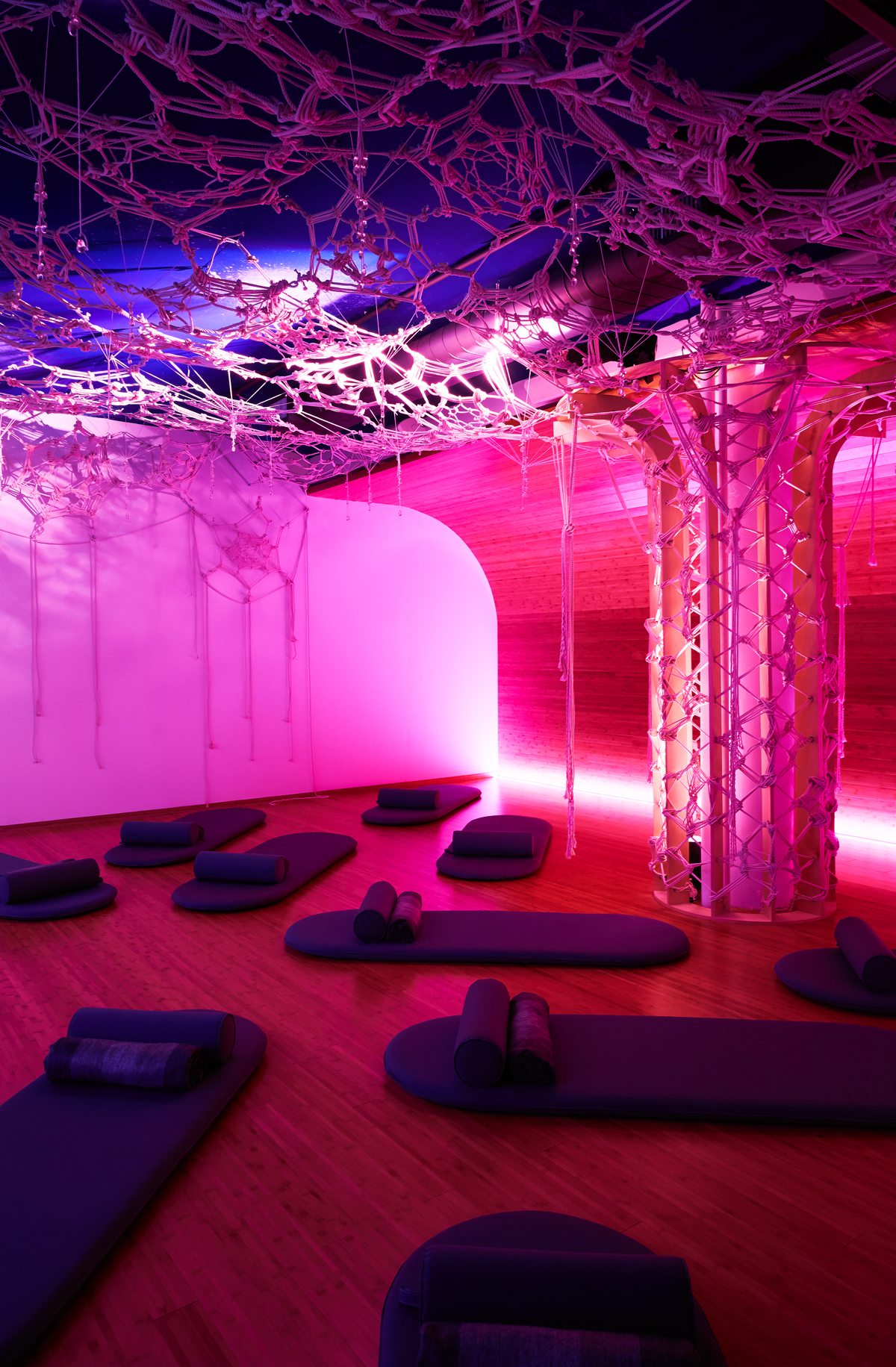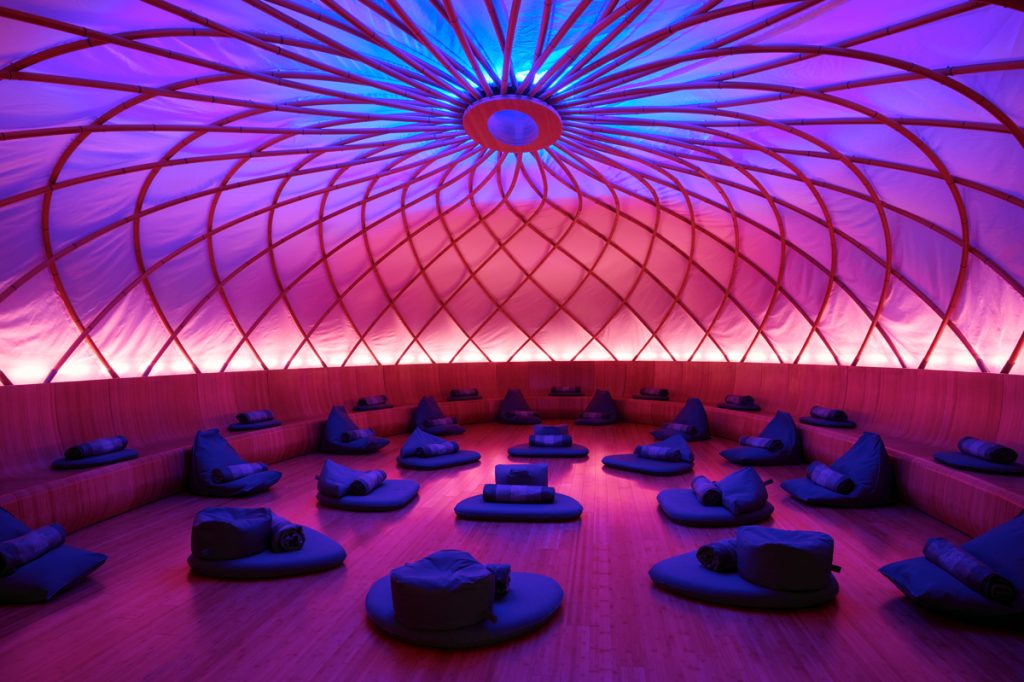I’m sprinting up Fifth Avenue one recent evening, vaulting over slush puddles with minutes to spare until the start of my 8 p.m. meditation session. Panting, I slam through the glass doors of Inscape, a new secular for-profit meditation center in New York City’s Flatiron District, and hurtle toward the check-in iPad mounted on the reception desk, where my name is glowing. “I’m here . . . for the . . . Deep Sound session,” I gasp. Despite my uncool arrival, I am wondering if I will feel like a member of the emerging class of New Yorkers that Inscape appears to cater to— the hip urban meditator—and whether this is a class to which I want to belong.
Inscape, which opened in the fall of 2016, offers New Yorkers a sleek storefront space to try group meditation without the mantle of religious dogma. Many prospective meditators are understandably intimidated at the thought of approaching one of the city’s many traditional Buddhist sanghas: not only can practicing there feel like a commitment to a spiritual path, with its rules, hierarchies, and other trappings, but the spaces, though often lovely, don’t necessarily feel indulgent or client-focused.
Those latter qualities are central to Inscape’s appeal. From the moment you step through the door, it’s undeniable that Inscape is a luxury brand in keeping with founder Khajak Keledjian’s background: a former fashion mogul, he came to meditation to alleviate job stress. “Meditation has shifted,” he told me in an email interview. “It used to be about spirituality, but now people understand . . . how it can empower them to connect to their best selves . . . Meditation is an extension of a movement toward self-care. We see wellness as a new dimension of luxury.” Just as yoga and stationary cycling have enjoyed renaissances, becoming beacons for street fashion and barometers of the value of a half-hour of self-improvement, so too has nondenominational meditation. (See “Making Money with Meditation.”) The name Inscape refers to “the unique inner nature of a person,” though to me the word also suggests an “inner escape” from overstimulating city life—and perhaps even into an ideal vision of oneself. If you are one of the new class of New Yorkers who believe in the separation of sangha and cushion, who believes spirituality is about the self rather than its eradication, then Inscape might be just the place for you.
As my pulse slows in the serene lobby, replete with pillows and scent-infused air, one of the center’s sylphlike facilitators smiles at me. “No rush. It’s all good,” she says, adjusting the black pashmina wrap that’s part of the staff uniform. I follow her past two lounge areas (beanbag chairs, mindful coloring books, a wall hashtag: #meditationreimagined) to the Alcove, the smaller of Inscape’s two womblike meditation rooms—perhaps the most wow-inducing aspect of the center.
Keledjian describes Inscape’s vibe as “somewhere between 4th-century monasteries, the mood in the Temple at Burning Man, and the feeling you get when you look at the infinite horizon line.” The Alcove, intended for reclining practice, does indeed channel the Burning Man aesthetic with its macramé and crystal ceiling web, which makes for excellent overhead eye candy (Keledjian says the art installation will change periodically). The Dome, the room used for seated sessions, feels more monastic, with bamboo rafters arcing toward an oculus.
This curated aesthetic inspires a sense of acquisitiveness that challenges the basics of mind and breath. Once you sit on a bespoke cushion, wrapped in an alpaca throw, preparing to be in the moment, it’s hard to resist the pull of desire—for a lifestyle that allots time and money for wellness or even for a $12 wooden wishbone from the lobby gift shop—that markedly doesn’t jibe with traditional Buddhist philosophy, which pinpoints craving as the source of suffering. Keledjian described Inscape’s philosophy as “merging tradition, modern thinking, and of-the-moment tech to reimagine meditation and relaxation and enhance 21st-century living. Our experiences are designed to make meditation accessible and relevant to everyone, of all philosophies.” He doesn’t believe people should have to commit to the same practice each day: “Whatever you enjoy most is what you should do. [Meditation] should not be another ‘to-do.’”

Inscape offers a schedule of guided meditations on a variety of themes in 22-, 33-, 44-, 66-, or 88-minute sessions, for between $18 and $29 each, an average of about 50 cents per minute. Multi-session packages and unlimited memberships are also available. A complementary app features a free five-day trial course; after that, the subscription is $12.99 per month or $89.99 per year. The classes held in the Dome include Focus, which guides you in placing your attention on a single thing (your breath, an object); Mindfulness, which emphasizes open, nonjudgmental awareness; Mantra, which asks practitioners to silently repeat a phrase to focus their meditation; and Visualization, which encourages participants to use their imaginations to stimulate compassion and positivity. Held in the Alcove, Deep Breath uses breathing as a focus for mindfulness; Deep Rest guides you into an extended period of reclined relaxation; and Deep Sound—one of the most popular classes—sends meditators on a sonic journey using a recorded, “handcrafted” sound sequence.
“Facilitators”—Inscape’s name for the employees who start and end each session, ensure comfort, and dispense advice—don’t lead the sessions, however. They serve more as chaperones, sitting alongside clients with a pillow marked “FACILITATOR.” In lieu of a human leader, Skye, a recorded female voice with an appealing Australian-ish accent, provides instruction through surround-sound speakers, guiding clients in Inscape’s signature flow of stretches and breathwork, mantras, soundscapes, and (less often than one might want) silence. The audio-guided platform is intentional, Keledjian says, providing a neutrality and consistency not possible from a live teacher.
Although initially I was put off by the audio—it seemed like a bit of a ripoff—I came to appreciate the absence of a distracting personality. Skye’s voice felt like being wrapped in a warm towel, gentle and nurturing without being overbearing. The sessions had a bit too much talking and stretching for my taste, though: I just wanted to get down to business and sit still in silence. That said, the instructions were clear and encouraging, and the ambience soothed my busy mind. At the three sessions I attended, at various times and on various days, there were about six to 10 other guests, who seemed to be mostly in their 30s, 40s, and 50s, well-dressed, and from a variety of racial backgrounds.
I step through the door of the Alcove and recline on my bolstered mat, waiting for Deep Sound to begin. Gazing up at the crystals dangling tantalizingly out of reach, it occurs to me that maybe the appeal of Inscape is this very element of desire, that eternal fulcrum that drives consumption—of objects, of time, and also of identity. The desire to be someone who can sit still for half an hour, mindfully drink a cup of strawberry-mint water, tuck a box of “Sex Dust” into her tote bag, and exit into the city more fully present for the next happening—and return the next day for more of the same, becoming gradually more balanced, more aware. Maybe the end justifies the means.
The lights dim and the sound sequence begins, the synth music building from birdsong and bells to a frightening drumming before returning to chimes. Watching my mind and breath react to each change in tone and tempo, I become more aware of its workings. Your mind is, after all, just your mind, whether you are on a cushion or a plastic seat on the F train. At the end of the session, as I mindfully sip my infused water, sample (but don’t buy) some lotion, and push back through the glass doors into the city’s own breath, I keep in mind Skye’s parting instruction before her voice dissolved into the ceiling web: “Travel gently.”
Thank you for subscribing to Tricycle! As a nonprofit, we depend on readers like you to keep Buddhist teachings and practices widely available.
